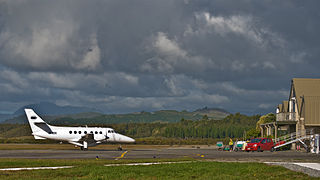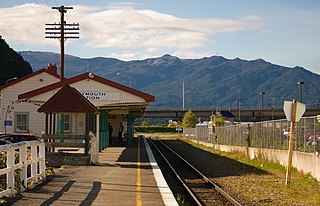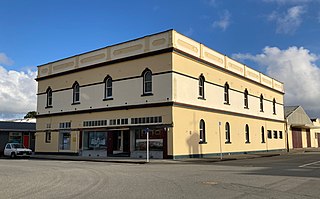Related Research Articles

The West Coast is a region of New Zealand on the west coast of the South Island that is administered by the West Coast Regional Council, and is known co-officially as Te Tai Poutini. It comprises the territorial authorities of Buller District, Grey District and Westland District. The principal towns are Westport, Greymouth and Hokitika. The region, one of the more remote areas of the country, is also the most sparsely populated. With a population of just 32,000 people, Te Tai Poutini is the least populous region in New Zealand, and it is the only region where the population is declining.

ASB Bank Limited, commonly stylised as ASB, is a bank owned by Commonwealth Bank of Australia, operating in New Zealand. It provides a range of financial services including retail, business and rural banking, funds management, as well as insurance through its Sovereign Limited subsidiary, and investment and securities services through its ASB Group Investments and ASB Securities divisions. ASB also operated BankDirect, a branchless banking service that provides service via phone, Internet, EFTPOS and ATMs only.

The Trustee Savings Bank (TSB) was a British financial institution. Trustee savings banks originated to accept savings deposits from those with moderate means. Their shares were not traded on the stock market but, unlike mutually held building societies, depositors had no voting rights; nor did they have the power to direct the financial and managerial goals of the organisation. Directors were appointed as trustees on a voluntary basis. The first trustee savings bank was established by Reverend Henry Duncan of Ruthwell in Dumfriesshire for his poorest parishioners in 1810, with its sole purpose being to serve the local people in the community. Between 1970 and 1985, the various trustee savings banks in the United Kingdom were amalgamated into a single institution named TSB Group plc, which was floated on the London Stock Exchange. In 1995, the TSB merged with Lloyds Bank to form Lloyds TSB, at that point the largest bank in the UK by market share and the second-largest by market capitalisation.

Hokitika is a town in the West Coast region of New Zealand's South Island, 40 kilometres (25 mi) south of Greymouth, and close to the mouth of the Hokitika River. It is the seat and largest town in the Westland District. The town's estimated population is 2,910 as of June 2021.

Ross is a small town located in the Westland District on the West Coast of New Zealand's South Island, 27 kilometres (17 mi) south-west of Hokitika and 46 kilometres (29 mi) north-east of Hari Hari by road.

Trust Bank New Zealand Ltd was a registered bank that operated in New Zealand between 1986 and 1996. It was made up of the former regional savings banks that had their origins as far back as 1847. It was acquired by Westpac Bank in 1996 which phased out the Trust Bank brand at the end of 2002, when the bank was rebranded from WestpacTrust to simply Westpac.
TSB Bank Ltd trading as TSB, is a New Zealand bank with headquarters in New Plymouth. It has 25 branches across the country but is heavily focused on the Taranaki region where 12 of its branches are located.

Hokitika Aerodrome is a small, uncontrolled aerodrome located 1.9 km north east of Hokitika in the suburb of Seaview on the West Coast of the South Island of New Zealand. It is also the closest domestic airport with scheduled flights to the town of Greymouth 40 km further north, the largest settlement on the coast.

The Midland line is a 212 km section of railway between Rolleston and Greymouth in the South Island of New Zealand. The line features five major bridges, five viaducts and 17 tunnels, the longest of which is the Otira tunnel. It is the route of the popular TranzAlpine passenger train.

The Ross Branch, officially known as the Hokitika Line since 2011, and previously as the Hokitika Industrial Line, is a branch line railway that forms part of New Zealand's national rail network. It is located in the Westland District of the South Island's West Coast region and opened to Hokitika in 1893. A further extension to Ross operated from 1909 until 1980.

James Cuthbert Mercer was a pioneer New Zealand aviator, establishing the country's first commercial airline, Air Travel (NZ) Ltd, in 1934 based around services operating between Hokitika and settlements in South Westland.
Robert Caldwell Reid was a 19th-century Member of Parliament from the West Coast, New Zealand. Born in Scotland and attracted by the gold rushes in Victoria and the West Coast, he was later the proprietor of a series of newspapers.

Eastern & Central Savings Bank was a savings bank that operated in New Zealand between 1972 and 1987. It was the result of a merger between two smaller regional savings banks; Hawke’s Bay and Gisborne Savings Bank and Manawatu Wairarapa Savings Bank. Fifteen years later it absorbed the customers of Trust Bank Wanganui to become Trust Bank Central.

Westland County, also known as County of Westland, was a local government area on the West Coast of New Zealand's South Island. It existed from 1868 to 1873, and then from 1876 until 1989. In its first incarnation it constituted the government for the area that was split from the Canterbury Province, with the West Coast Gold Rush having given the impetus for that split. It had the same administrative powers as a provincial council, but the legislative power rested with Parliament in Wellington. The first Westland County was the predecessor to Westland Province.

Hokitika Museum is a museum in Hokitika on the West Coast of the South Island in New Zealand, and is the West Coast's largest museum and archive. It is housed in the historic Hokitika Carnegie Library building. Exhibitions include information about the gold rush and the unique West Coast stone pounamu (greenstone) and its value to Māori. The museum also holds a significant photographic collection. Seismic strengthening requirements closed the museum in September 2019. According to the Westland District Council Web site as of December 2021 the museum had not yet reopened.

The Hokitika Clock Tower, initially called the Westland War Memorial and then the Coronation and War Memorial, is a prominent landmark in Hokitika, New Zealand. The memorial was initiated, fundraised for, and carried out by a committee, to commemorate the region's contribution to the Second Boer War; not just the four local men who had died but all 130 who had gone to war in South Africa. An additional purpose was to provide Hokitika with a town clock.

This statue of Richard Seddon is in Hokitika, on the West Coast of the South Island of New Zealand. The statue is situated on Sewell Street, outside the Government Buildings known as Seddon House.

The Renton Hardware building, also known as the Okitiki building, is a commercial building in Hokitika, on the West Coast of New Zealand's South Island. Completed in 1908, the building was designed by architect Arthur Griffin, who was also responsible for the nearby Carnegie library. In 1989, the Renton building was granted historic place category 2 status by Heritage New Zealand.

The Westland District Library is the public library in Hokitika, on the West Coast of New Zealand. Beginning as the Hokitika Literary Society in 1866, it occupied a Carnegie library building from 1908 as the Hokitika Free Public Library, moving out in 1975.

The Hokitika Savings Bank building is a former bank building in Hokitika, on the West Coast of New Zealand's South Island. Completed in 1927, the building was granted historic place category 2 status by Heritage New Zealand in 1989.
References
- 1 2 3 4 'Liberalisation of financial markets in New Zealand' Arthur Grimes, Institute of Policy Studies, Victoria University of Wellington, Wellington, 1998. Retrieved 11 February 2006.
- ↑ 'From competition to cohesion: the changing focus of economic development in New Zealand' Paul Killerby and Joanna Smith, NZ Institute of Economic Research (Inc.) Wellington (2001). Retrieved 11 February 2006
- ↑ "Hokitika Savings Bank Building (Former)". Heritage New Zealand. Retrieved 29 June 2022.